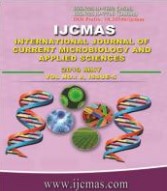


 National Academy of Agricultural Sciences (NAAS)
National Academy of Agricultural Sciences (NAAS)

|
PRINT ISSN : 2319-7692
Online ISSN : 2319-7706 Issues : 12 per year Publisher : Excellent Publishers Email : editorijcmas@gmail.com / submit@ijcmas.com Editor-in-chief: Dr.M.Prakash Index Copernicus ICV 2018: 95.39 NAAS RATING 2020: 5.38 |
Abiotic stresses are one of the key limitations to global crop production and food security. Among the abiotic stresses, drought is one of the most vital factors that causes change in morphological, biochemical and physiological characteristics in plants, and consequently affects the growth and productivity of crops. The main purpose of the present study was to evaluate the effect of drought on morphological [Plant height, root length (cm), shoot length (cm), number of branches, yield attributing traits], physiological ratio of root/shoot length, leaf area (cm2), relative water content (%), and electrolyte leakage (% conductivity) and biochemical traits [ascorbic acid content (mg/100g), total carotenoids (mg/100g), total chlorophyll content, proline, sugar content] in 15 tomato genotypes and to identify drought stress tolerant genotypes. The results confirmed that there are significant variations in agronomic, physiological and biochemical parameters among 15 tomato genotypes under drought and irrigated conditions. Among the 15 genotypes, EC-317-6-1 and WIR-4360 were found highly tolerant to drought in comparison to others while Kashi Amrit and Kashi Sharad were found susceptible to drought conditions. The performance of tomato genotypes used in the study showed significant differences in all studied traits, suggesting that they could be taken into account when selecting for drought tolerance. EC-317-6-171 and WIR-4360 had good yield performance under deficit irrigation treatment. Moreover, results indicate that biochemical and physiological parameters are more useful for the screening of drought tolerant tomato genotypes.
 |
 |
 |
 |
 |